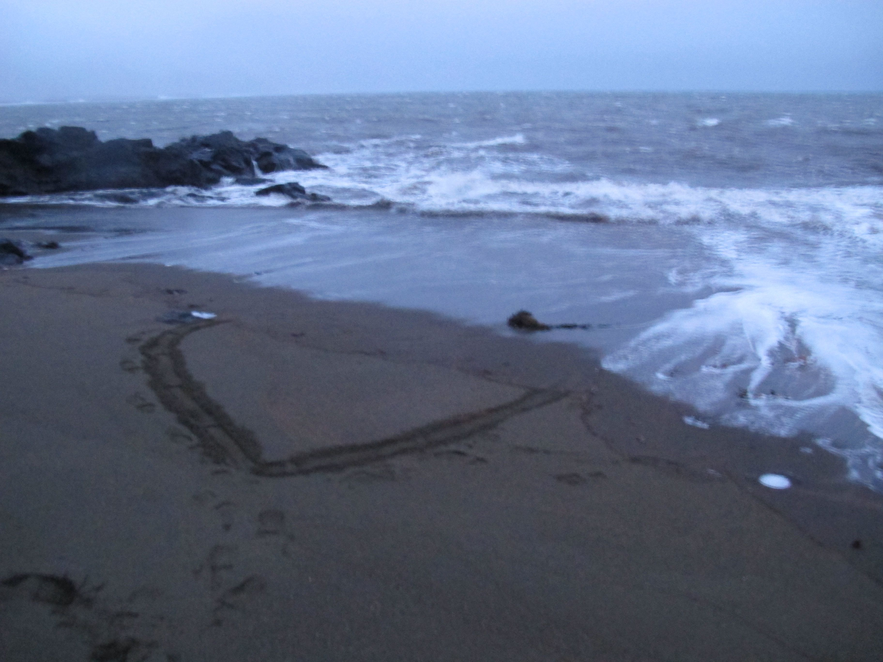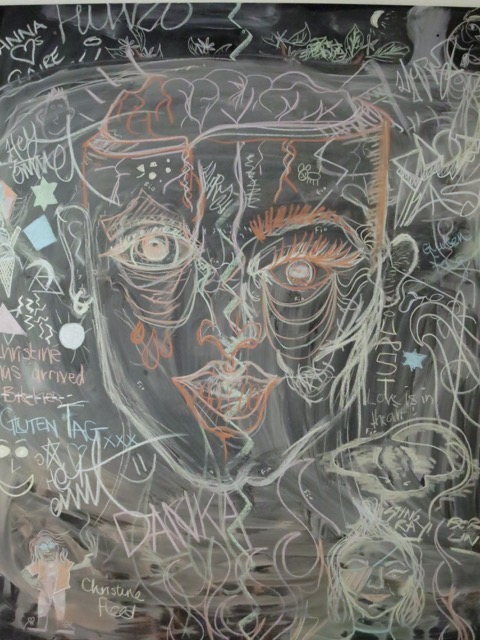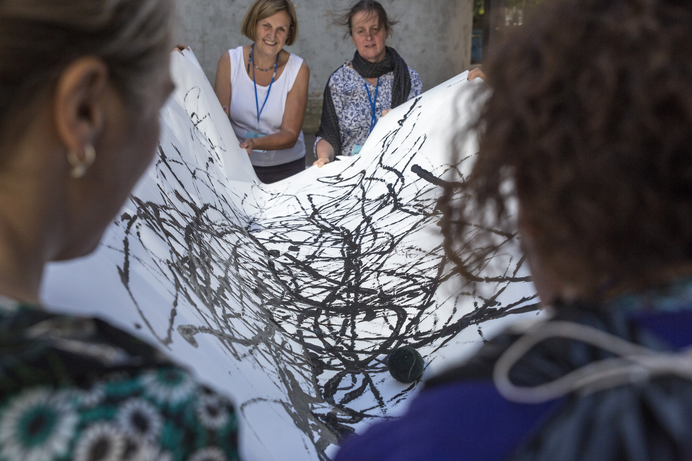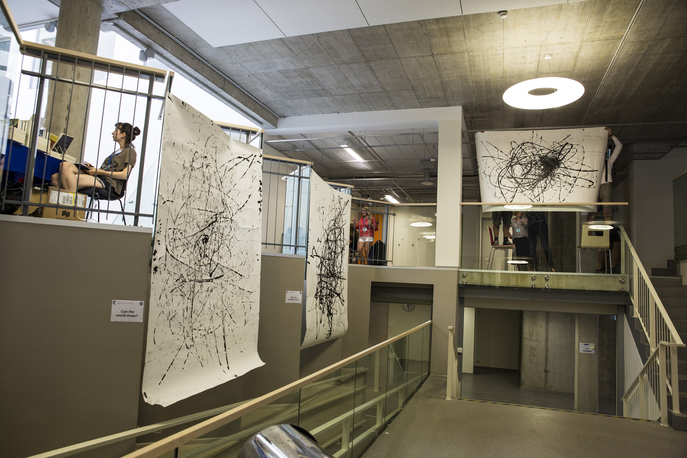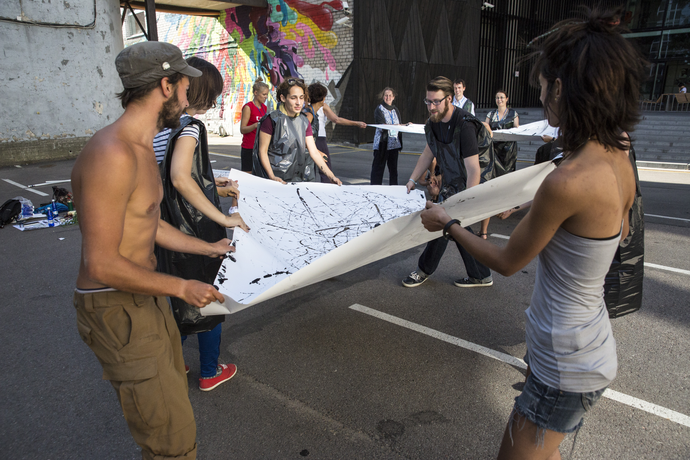How to recognize this kind of activity that is ‘at the cusp’ (Massumi 2013, 3)? What does it look like? How to visualize or imagine bare activity that may or may not turn into a singular event?
Google’s image search presents activity as something akin to games, playing and running. In our collective image repertoire, as represented and filtered by Google’s algorithms, activity appears as if synonymous with doing without any immediately understandable meaning or goal that is achieved through planning and some implementation of the plan, such as running on a treadmill. And this view on activity does not even have the prefix ‘bare’.
When leafing through my own image files, I cannot help thinking that for me bare activity reveals itself, for example, in the image of the Unscharfer Langläufer, a cross-country skier on the Berlin Tempelhof after only a few millimetres of snow had fallen. His skiing is at the cusp of turning into enjoyable sport, but it will most likely remain in the state of just-beginning-to-stir. Imagining what bare activity could look like in my own life, I think of me walking in a circle on an empty beach knowing that the figure I leave behind will soon be washed away by the waves.
Or when taken to the realm of art and theory, I see something like asemic writing, meaning writing that is wordless and has no specific semantic content. In other words, it is writing in which the process of writing overcomes or challenges any idea of a perceivable meaning. The asemic text may turn into a singular new event and leave creatively behind the background activity, but in most cases, I believe, it remains a raw and nude activity, that is bare activity in the everyday sense of the word.
Bare activity in art could also represent itself in the drawings on the chalkboard in the Berlin apartment I rent. These chalkboard drawings may occur as art and make the next tenant experience something singular, but it is more likely that the next guest will wipe the board clean. Still the tenants leave their bare marks on the board.
Equally, when thinking of bare activity and art as a process, I might think of the workshop on collaborative art in Tallinn in the summer 2014. In the workshop we, the participators, held together a large piece of paper. We set a ball saturated in ink on the paper and started to move the paper, letting the ball do its work and write its stories.
In the workshop, as you can see, we, the participators, were exited and laughing, but hardly anyone else, meaning the Others or the outsiders, could get anything out of our bare activity. For us, the workshop was a fun, and even inspiring, game, but others were left outside.
In the workshop, I learned something of the ways in which bodily co-operation works, as we needed to adjust our movements to the movements of the others in order not to break the paper. Equally, I realized how difficult or futile it was to make any plans or set any goals for the collaboration because in most cases, the group did not pay much attention if someone had a specific suggestion, or alternatively the participators were too restless to execute any ideas or plans for more than a fleeting moment.
Something similar happened when I organised a small event on collaborative writing in my Helsinki-based, second-hand bookstore, Antikvariaatti Sofia. Visitors were supposed to pick up a text fragment from any of the books in the shop and retype it into a Word-file that was projected on a canvas. While someone was writing, others could watch as the collaboratively written text collage was produced in situ. We, or at least I, had fun while doing and watching it, but I doubt if anything else came out of the event. I, or we, never published the text anywhere, until now here on Ruukku.
Such mode of operation that rests on experimenting and testing, rather than mutual planning, dialogue and dialectic revising, might of course be more typical for short-term collaborations than for long-term co-operations. Thus, it is not an essential character of collaboration per se, but it is useful to remember that in most cases of contemporary community art, relational art and artistic collaborations of more than two people, the collaborators do not share a long history or have a long-term commitment of collaboration with each other. Moreover, the workshop form itself can be seen as a popular mode of temporary, short-term collaboration.
When the process of collaboration takes place in situ in a workshop or an event, long-term communal transformations or bonds can hardly be anticipated or even hoped for. What, in turn, can be expected are private inspirations or epiphanies among individual collaborators. In this sense, Massumi (2013, 2) is right when writing that ‘process as becoming is not just creative activity, it turns out. It is self-creation. More than that, the self-creation is “enjoyed”’. I enjoyed the workshop in Tallinn, as well as the event in the bookshop, and walking on the beach marks one of the happiest moments in my life, my honeymoon, when everything I needed or wanted was there, and I did not look back nor dread the future.
Oikeudenmukaisuuden kannalta oleellisen ja epäoleellisen sattuman erottaminen perustuu siis siihen, voiko lopputulokseen vaikuttaa järjestelyjä muuttamalla. On täysin selvää, että jos Felice olisi asunut Prahassa, mitään suhdetta ei olisi koskaan syntynyt. Heitä syytettiin poliisin vastustamisesta, jopa kapinasta. Mutta pyssyn ottaa Felice, ja pakoon puikkii Nalle. Tarkastetaan vielä, onko vanhan herran poskipäillä oikea viininpunainen vivahdus. Unta on vaikea saada, jos keho on jännittynyt tai levoton.
Perustelu tehosi Kekkoseen. Hän ryhtyi suunnittelemaan Suomen asemaa selventävää kannanottoa. Nyt on täsmälleen sama pulma korostunut tietotekniikkaa taitavien ylempien toimihenkilöiden kohdalla.
Parhaiten myötä- ja vastatuulen eron havaitsee tutkan avulla, jolla päivä- ja yömuuton korkealla myötätuuleen havaitsee paljon helpommin kuin maastossa kiikaroimalla tai kuuntelemalla. Keskustelujen pohjalta koraalikomiteaa täydennettiin ja se velvoitettiin ottamaan virsisävelmistöön myös hengellisiä kansansävelmiä, jotka olivat herättäneet tavatonta innostusta kansan keskuudessa mutta puuttuivat lähes kokonaan komitean valmistamasta vuoden 1889 sävelmistöstä. Sono perplesso.
Il ritmo del discorso consentiva al pubblico di seguirlo senza problemi, nonostante il suo accento greve. Al termine di ogni periodo concedeva il tempo per riflettere su tutte le implicazioni di cio´che aveva appena detto Sabbath si godeva le pause non meno della monotonia delle frasi opache che esse separavano, frasi che li fecero ricordare, per la prima volta da molti anni, un arcipelago solitario di isole inabitabili che le navi mercantili incontravano al largo di Veracruz, uscendo dal porto in direzione sud.
Chi la fa l’aspetti, dice l’adverbio; e chi asino e´e cervio essere si crede, perde l’amico e dinari non ha mai.
On hämmästyttävää, mutta kuitenkin totta, että kaksi kolmasosaa turmioon joutuneista tytöistä on langennut tanssin vaikutuksesta.
”Ja .. jag fattade nog inte riktigt ”, sa Ru långsamt, ”att trädklättring var en del av att sätta upp en gunga.”
”Uskon jälkisarjallisen musiikin tulevaisuuteen; suodatetun sarjallisuuden vaikutuksesta musiikillinen sanavarasto laajeni […] Musiikin tulee olla kiitollinen lyhyelle mutta ankaralle sarjalliselle vaiheelle, joka 1950-luvun lopulla käytiin läpi.” (Esa-Pekka Salonen vuonna 1987)
Aseta lampaankylkirivit isoon, laakeaan muovi- tai posliiniastiaan.
-mitä asia koskee? –tämä on valtaus, kautta pukin sarvien! – Se on mahdotonta. Kun näin hänet Roomassa, annoin hänelle kultaa ja hän lupasi olla hyökkäämättä kimppuumme. –Vai niin, petturi! – Minäkö petturi? – Ja missä se kulta nyt on? –Minä en ole petturi enkä turkkilainen! – Auri sacra fames. – Ja sinä hienostunut latinisti, sinä alat… -Boing! Minä tein valtavan vuodon laivaan! –Mutta mehän uppoamme! –Oikein arvattu, täydet pisteet.
Paljon on tehty, jotta saataisiin luoduksi ydinaseita vastustava yleinen mielipide, mutta ei vielä tarpeeksi, jotta pystyttäisiin vaikuttamaan hallituksiin. Uhkaava tuho on niin valtava, että meidän mielestämme on pakko ryhtyä jokaiseen mahdolliseen toimenpiteeseen kansalaistemme ja viime kädessä kaikkien ihmisten herättämiseksi tajuamaan, että kiireelliset ja perusteelliset politiikan muutokset ovat tarpeen.
Arthur Dent ajatteli alistuneesti, että ihan ensimmäiseksi hänen oli järjestettävä itselleen elämä. Ymmärsin tietenkin, ettei ollut mitään oikotietä.
Luonto on uskonnon ensimmäinen ja perustava kohde, mutta silloinkaan, kun luonto on uskonnollisen palvonnan välitön kohde, kuten luonnonuskonnoissa, se ei ole tällaisena kohteena luontona ts. sillä tavalla kun me tarkastelemme sitä teismin tai filosofian ja luonnontieteen kannalta.
Ihminen voi elää elämäänsä vapaana vain silloin, kun hän ei vääristä sitä jonkin teorian palvelemiseen tai vääristy itse teorioita kumartaessaan.
Happy people never count hours as they pass by.
In short, any astronomer could have discovered Uranus if he had looked for it.
Erään tällaisen ilmaisun kohdalla purskahtivat kaikki kolme yhtä aikaa nauramaan, ja Karl pelkäsi jo tehneensä karkean virheen; mutta ei, hän oli sanonut jotakin erittäin onnistunutta, selitti herra Pollunder.
Uros tuottaa suuren kurkkupussin avulla sointuvan huhuiluäänen, joka voimakkuudeltaan on verrattavissa leijonan karjuntaan.
